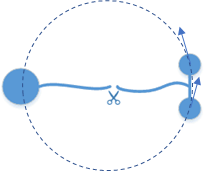Take a ball of radius $r$ connected to a thin center-post by string of length $R$. The post accelerates up to and stays at a high final rotation speed $\Omega$. Obviously the ball revolves at $\Omega$. Now imagine case 2 where a thin, light ball-bearing is connected to the string and the ball rotates within it.
Lookin down along the axis of rotation, draw an arrow ⬆️ on the top of the ball. In case 2 it always points the same way, and in case 1 it rotates once per revolution.
At the same angular velocity $\Omega$ of the system:
$$ v_1=v_2 =v= \Omega (R+r) $$ $$ \omega_1 = \Omega ~,~ \omega2 = 0$$
By conservation of angular and linear momentum, after the cut:
$$v_{1,f}=v= \Omega (R+r) ~,~ \omega_{1,f}= \Omega$$
$$v_{2,f}=v= \Omega (R+r) ~,~ \omega_{2,f}= 0$$
Yes it spins as it travels away no matter what shape it is.
In your lower pic the tangent velocities are not parallel for the two balls.
By the way, the kinetic energy in case 1 is higher: $$E_1= \frac{1}{2} m v^2 + \frac{1}{2} I_{ball} \omega^2$$ where $I_{ball}$ is the moment of inertia of a sphere around around its axis. The second term is gone for case 2:
$$ E_2= \frac{1}{2} m v^2= \frac{1}{2} I_{mass} \Omega^2$$
where $I_{mass}$ is the moment of inertia of a point-mass in revolution, $m(R+r)^2$ in this case. We also just derived the parallel axis theorem where $E_1= \frac{1}{2} I_{tot} \Omega^2$ and $I_{tot}=I_{mass}+I_{ball}$.



